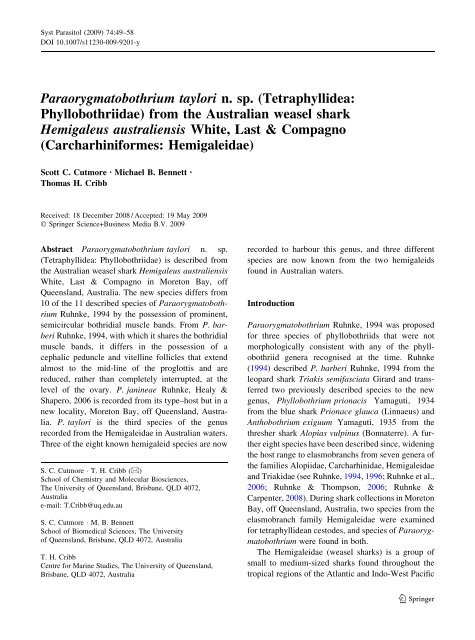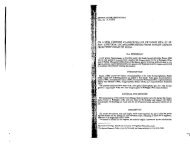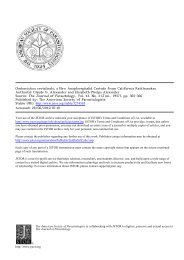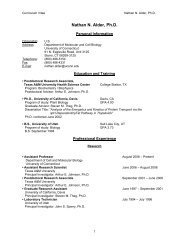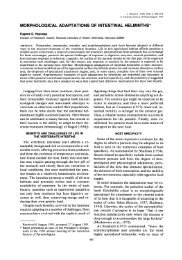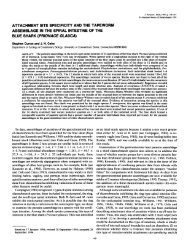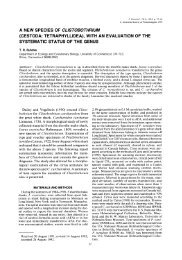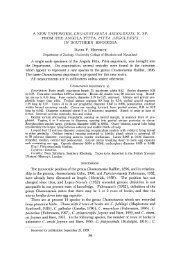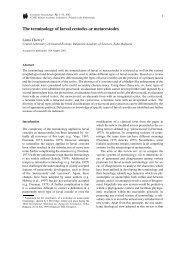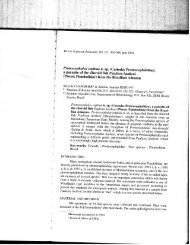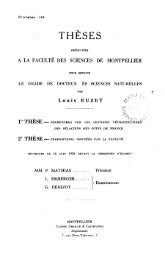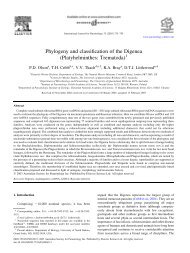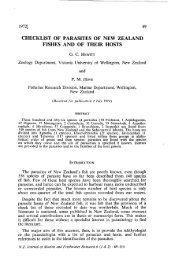Paraorygmatobothrium taylori n. sp. (Tetraphyllidea ...
Paraorygmatobothrium taylori n. sp. (Tetraphyllidea ...
Paraorygmatobothrium taylori n. sp. (Tetraphyllidea ...
Create successful ePaper yourself
Turn your PDF publications into a flip-book with our unique Google optimized e-Paper software.
Syst Parasitol (2009) 74:49–58DOI 10.1007/s11230-009-9201-y<strong>Paraorygmatobothrium</strong> <strong>taylori</strong> n. <strong>sp</strong>. (<strong>Tetraphyllidea</strong>:Phyllobothriidae) from the Australian weasel sharkHemigaleus australiensis White, Last & Compagno(Carcharhiniformes: Hemigaleidae)Scott C. Cutmore Æ Michael B. Bennett ÆThomas H. CribbReceived: 18 December 2008 / Accepted: 19 May 2009Ó Springer Science+Business Media B.V. 2009Abstract <strong>Paraorygmatobothrium</strong> <strong>taylori</strong> n. <strong>sp</strong>.(<strong>Tetraphyllidea</strong>: Phyllobothriidae) is described fromthe Australian weasel shark Hemigaleus australiensisWhite, Last & Compagno in Moreton Bay, offQueensland, Australia. The new <strong>sp</strong>ecies differs from10 of the 11 described <strong>sp</strong>ecies of <strong>Paraorygmatobothrium</strong>Ruhnke, 1994 by the possession of prominent,semicircular bothridial muscle bands. From P. barberiRuhnke, 1994, with which it shares the bothridialmuscle bands, it differs in the possession of acephalic peduncle and vitelline follicles that extendalmost to the mid-line of the proglottis and arereduced, rather than completely interrupted, at thelevel of the ovary. P. janineae Ruhnke, Healy &Shapero, 2006 is recorded from its type–host but in anew locality, Moreton Bay, off Queensland, Australia.P. <strong>taylori</strong> is the third <strong>sp</strong>ecies of the genusrecorded from the Hemigaleidae in Australian waters.Three of the eight known hemigaleid <strong>sp</strong>ecies are nowS. C. Cutmore T. H. Cribb (&)School of Chemistry and Molecular Biosciences,The University of Queensland, Brisbane, QLD 4072,Australiae-mail: T.Cribb@uq.edu.auS. C. Cutmore M. B. BennettSchool of Biomedical Sciences, The Universityof Queensland, Brisbane, QLD 4072, AustraliaT. H. CribbCentre for Marine Studies, The University of Queensland,Brisbane, QLD 4072, Australiarecorded to harbour this genus, and three different<strong>sp</strong>ecies are now known from the two hemigaleidsfound in Australian waters.Introduction<strong>Paraorygmatobothrium</strong> Ruhnke, 1994 was proposedfor three <strong>sp</strong>ecies of phyllobothriids that were notmorphologically consistent with any of the phyllobothriidgenera recognised at the time. Ruhnke(1994) described P. barberi Ruhnke, 1994 from theleopard shark Triakis semifasciata Girard and transferredtwo previously described <strong>sp</strong>ecies to the newgenus, Phyllobothrium prionacis Yamaguti, 1934from the blue shark Prionace glauca (Linnaeus) andAnthobothrium exiguum Yamaguti, 1935 from thethresher shark Alopias vulpinus (Bonnaterre). A furthereight <strong>sp</strong>ecies have been described since, wideningthe host range to elasmobranchs from seven genera ofthe families Alopiidae, Carcharhinidae, Hemigaleidaeand Triakidae (see Ruhnke, 1994, 1996; Ruhnke et al.,2006; Ruhnke & Thompson, 2006; Ruhnke &Carpenter, 2008). During shark collections in MoretonBay, off Queensland, Australia, two <strong>sp</strong>ecies from theelasmobranch family Hemigaleidae were examinedfor tetraphyllidean cestodes, and <strong>sp</strong>ecies of <strong>Paraorygmatobothrium</strong>were found in both.The Hemigaleidae (weasel sharks) is a group ofsmall to medium-sized sharks found throughout thetropical regions of the Atlantic and Indo-West Pacific123
50 Syst Parasitol (2009) 74:49–58(Compagno et al., 2005). There are eight <strong>sp</strong>eciesdescribed worldwide, and two are found in Australianwaters, the Australian weasel shark Hemigaleus australiensisWhite, Last & Compagno and the snaggletoothshark Hemipristis elongata (Klunzinger) (seeCompagno et al., 2005; Last & Stevens, 2009).Hemigaleus australiensis is endemic to Australia,occurring on the continental and insular shelves offQueensland, the Northern Territory and WesternAustralia, and is a <strong>sp</strong>ecialist cephalopod feeder(White et al., 2005; Taylor & Bennett, 2008). Hemipristiselongata is found throughout the Indo-WestPacific and has a similar distribution to Hemigaleusaustraliensis in Australian waters (Compagnoet al., 2005; Last & Stevens, 2009). The <strong>sp</strong>ecimensof Hemipristis elongata recovered in this studyrepresent a southerly range extension of about650 km for the <strong>sp</strong>ecies on the east Australian coast.This <strong>sp</strong>ecies has a broader diet than Hemigaleus australiensis,feeding on cephalopods, teleosts and otherelasmobranchs (Last & Stevens, 2009).Two <strong>sp</strong>ecies of <strong>Paraorygmatobothrium</strong> have beendescribed from hemigaleid sharks. Ruhnke et al.(2006) described P. janineae Ruhnke, Healy &Shapero, 2006 from Hemipristis elongata off theNorthern Territory, Australia and P. kirstenaeRuhnke, Healy & Shapero, 2006 from Hemigaleusmicrostoma Bleeker, the sicklefin weasel shark,from off Sarawak, Malaysia and the Northern Territory,Australia. In this study, examination of hemigaleidsharks from Moreton Bay yielded two <strong>sp</strong>eciesof <strong>Paraorygmatobothrium</strong>. A new <strong>sp</strong>ecies was foundin Hemigaleus australiensis; this is described hereand its relationship to the other described <strong>sp</strong>ecies of<strong>Paraorygmatobothrium</strong> is discussed. Specimens ofP. janineae were found in Hemipristis elongata andrepresent a new locality record.Materials and methodsBetween December, 2004 and September, 2007 six<strong>sp</strong>ecimens of Hemigaleus australiensis (three maleand three female) and two <strong>sp</strong>ecimens of Hemipristiselongata (one male and one female) were collectedfrom Moreton Bay, Queensland. Spiral intestines wereremoved and stored on ice (\4 h) prior to examination.Each <strong>sp</strong>iral intestine was opened longitudinally andexamined under a dissecting microscope. Cestodeswere removed, washed in vertebrate saline and killedin near-boiling vertebrate saline. Worms were fixed in10% formalin for morphological examination and both10% formalin and Karnovsky’s fixative (2% paraformaldehydeand 2.5% glutaraldehyde in 0.1 M sodiumcacodylate buffer; pH 7.4) for scanning electronmicroscopy (SEM).Specimens for morphological analysis were washedin freshwater, stained in Mayer’s haematoxylin,destained in hydrochloric acid and neutralised in0.5% ammonium hydroxide solution. Specimens werethen dehydrated in a graded ethanol series, cleared inmethyl salicylate and mounted in Canada balsam.Measurements were made using a SPOT Insight TMdigital camera (Diagnostic Instruments, Inc.) mountedon an Olympus BH-2 compound microscope usingSPOT TMimaging software. Measurements are inmicrometres unless otherwise stated and are given asthe range followed in parentheses by the mean,standard deviation, number of worms measured (n)and the total number of measurements taken (n) ifmultiple measurements were taken per worm. For twodimensionalmeasurements, length is given beforewidth. Drawings were made with the aid of a drawingtube. Microthrix terminology follows that of Faliexet al. (2000).Specimens for SEM were dehydrated in a gradedalcohol series and then dried in a critical point dryer(Balzers 11 120 A Critical Point Drier, Balzers UnionLtd, Balzers, Principality of Liechtenstein). Specimenswere mounted on a carbon tab pin stub, <strong>sp</strong>uttercoatedwith platinum (EIKO IB-5 Ion Coater, EIKOEngineering Company, Ibaraki, Japan) and storedwith silica gel to absorb any residual moisture.Specimens were examined using a JEOL JSM 6300Fscanning electron microscope (JEOL Ltd, Tokyo,Japan). Specimens for cross-sectioning were preparedusing standard histological methods and weresectioned at 8 lm intervals.<strong>Paraorygmatobothrium</strong> <strong>taylori</strong> n. <strong>sp</strong>.Type-host: Hemigaleus australiensis White, Last &Compagno (Carcharhiniformes: Hemigaleidae), Australianweasel shark.Type-locality: Off St. Helena Island (27°22 0 S;153°11 0 E), Moreton Bay, off Queensland.Site: Spiral intestine.123
Syst Parasitol (2009) 74:49–58 51Prevalence: 5 of 6.Type-material: Holotype (QM G 231303) and fourparatypes (QM G 231304–7) deposited in theQueensland Museum, Brisbane, Australia.Etymology: This <strong>sp</strong>ecies is named for Dr StephenTaylor, whose assistance in the collection of the hostsharks was invaluable.Description (Figs. 1–10)[Based on 10 whole-mounts of mature <strong>sp</strong>ecimens, 20whole-mounts of immature <strong>sp</strong>ecimens, 2 cross-sectioned<strong>sp</strong>ecimens and 3 mature <strong>sp</strong>ecimens for SEM.]Worms euapolytic, 25.9–32.9 (29.1 ± 3; n = 5) mmlong; maximum width 480–983 (601 ± 150; n = 10)for mature <strong>sp</strong>ecimens—generally at mature proglottids,419–513 (469 ± 23; n = 13) for immature <strong>sp</strong>ecimens—generallyat scolex. Scolex tetrabothridiate,consisting of scolex proper and cephalic peduncle(Figs. 2, 5), 341–439 (375 ± 24; n = 18) 9 419–525(476 ± 25; n = 18). Bothridia 324–488 (371 ± 32;n = 25; n = 55) 9 215–332 (246 ± 21; n = 22;n = 43), with single loculus and single apical sucker.Apical sucker 60–76 (68 ± 4; n = 25; n = 51) indiameter. Bothridia possess two semicircular musclebands of equal size united at distinct lateral junction;portion of bothridia enclosed by semicircular musclebands sometimes protrudes convexly (Fig. 10). Proximalbothridial surfaces covered with serrate <strong>sp</strong>initrichesand long filitriches (Fig. 6). Distal bothridialsurfaces covered with elongate, moderately flattened<strong>sp</strong>initriches with lateral projections terminally and fewmedium length filitriches (Fig. 7). Distal rims ofbothridia lack elongate <strong>sp</strong>initriches and mediumlength filitriches (Fig. 8). Cephalic peduncle present(Fig. 8), covered with serrate <strong>sp</strong>initriches (Fig. 9).Neck present, 4.6–9.1 (6.6 ± 1.7; n = 5) mm long;surface of neck and strobila covered with scutes.Surface of neck and strobilar scutes consist of denselypacked filitriches.Proglottids slightly cra<strong>sp</strong>edote, 41–43 (42 ± 1;n = 3) in number. Immature proglottids squarish toslightly longer than wide, 294–655 (479 ± 92; n = 8;n = 24) 9 268–524 (395 ± 79; n = 8; n = 24) inmiddle third of strobila; length to width ratio 0.76–1.8:1 (1.25 ± 0.29; n = 8; n = 24). Terminal andsubterminal proglottids mature, much longer thanwide (Fig. 4), 1,137–2,608 (1,745 ± 379; n = 10;n = 30) 9 381–983 (562 ± 153; n = 10; n = 30);length to width ratio 1.89–4.71:1 (3.2 ± 0.71; n = 10;n = 30). Testes slightly oblong to round, 139–197(162 ± 14; n = 9; n = 25) in number in terminal andsubterminal proglottids, single layer deep, slightlysmaller in anterior region than those in posteriorregions, 34–76 (51 ± 9; n = 10; n = 90) 9 44–97(69 ± 12; n = 10; n = 90); length to width ratio0.41–1.1:1 (0.75 ± 0.11; n = 10; n = 90). Cirrus-sacirregular elongate-oval (Fig. 3), contains coiled cirrus,202–444 (287 ± 71; n = 9) 9 99–198 (147 ± 33;n = 9); length to width ratio 1.58–2.47:1 (1.97 ±0.29; n = 9). Cirrus armed with small microtriches.Vas deferens coiled, anterior to and bordering proximalportion of cirrus-sac. Vagina medial, extendingfrom genital atrium along anterior cirrus-sac marginand anterior margin of vas deferens to mid-line ofproglottis, then posteriorly along mid-line of proglottisto ovary. Genital atrium shallow. Genital pores lateral,alternating irregularly, 57–84% (67 ± 7; n = 10;n = 30) of proglottis length from posterior end ofproglottis. Ovary near posterior end of proglottis,lobulate, H-shaped in dorsoventral view, 193–370(258 ± 60; n = 10) 9 241–525 (343 ± 80; n = 10).Ovarian bridge in anterior portion of ovary. Ovicapt atposterior margin of ovarian bridge. Mehlis’ glandposterior to ovicapt, between posterior half of ovarianlobes, 88–111 (96 ± 8; n = 8) 9 67–85 (76 ± 7;n = 8). Vitellarium follicular, extends almost to midlinedorsally and ventrally, arranged in 2 lateral bandsof irregular-shaped, elongate follicles, reduced at levelof ovary and interrupted at level of cirrus-sac on poralside. Uterus ventral to vagina, median, extendsanteriorly from between posteriormost testes to posteriormargin of cirrus-sac in mature proglottids.Uterine duct dorsal to uterus, median, extends anteriorly,entering anterior half of uterus. Eggs not seen.Excretory ducts lateral.<strong>Paraorygmatobothrium</strong> janineae Ruhnke,Healy & Shapero, 2006New materialHost: Hemipristis elongata (Klunzinger) (Carcharhiniformes:Hemigaleidae), snaggletooth shark.Locality: Wynnum Banks (27°25 0 S; 153°10 0 E), MoretonBay, off Queensland.Site: Spiral intestine.Prevalence: 1 of 2.123
52 Syst Parasitol (2009) 74:49–58Figs. 1–4 <strong>Paraorygmatobothrium</strong> <strong>taylori</strong> n. <strong>sp</strong>. 1. Whole worm. 2. Scolex. 3. Detail of terminal genitalia. 4. Terminal proglottis,dorsal view. Scale-bars: 1, 1 mm; 2–4, 200 lm123
Syst Parasitol (2009) 74:49–58 53Figs. 5–10 Scanning electron micrographs of <strong>Paraorygmatobothrium</strong> <strong>taylori</strong> n. <strong>sp</strong>. 5. Scolex; numbers indicate where Figs. 6 and 7were taken. 6. Proximal bothridial surface. 7. Distal bothridial surface. 8. Cephalic peduncle; number indicates where Fig. 9 wastaken. Note distal rim of bothridia (indicated by white arrow). 9. Cephalic peduncle surface. 10. Scolex with portion of bothridiaenclosed by semicircular muscle bands protruding convexly (indicated by white arrow). Scale-bars: 5, 10, 100 lm; 6, 7, 9, 1 lm; 8,10 lm123
54 Syst Parasitol (2009) 74:49–58Specimens deposited: QM G 231309–14, deposited inthe Queensland Museum, Brisbane, Australia.Measurements (Figs. 11–15)[Based on 20 whole-mounts of mature <strong>sp</strong>ecimens and8 mature <strong>sp</strong>ecimens for SEM.] Worms 27.3–46.7(36.1 ± 4.3; n = 18) mm long; maximum width 811–1,083 (944 ± 84; n = 20) at scolex. Scolex (Figs. 11, 12)603–748 (680 ± 44; n = 20) long. Bothridia518–711 (626 ± 46; n = 20; n = 36) 9 387–581(483 ± 46; n = 20; n = 36). Apical sucker 82–116(97 ± 9; n = 20; n = 40) in diameter. Neck 6.7–10.5(8.4 ± 1.2; n = 10) mm long. Proglottids 48–80(62 ± 11; n = 9) in number. Immature proglottids409–615 (502 ± 57; n = 16; n = 48) 9 400–691(518 ± 64; n = 16; n = 48) in middle third ofstrobila; length to width ratio 0.78–1.44:1 (0.98 ±0.16; n = 16; n = 48). Terminal and subterminalproglottids mature, 977–2,198 (1,549 ± 253; n = 20;n = 59) 9 472–861 (637 ± 86; n = 20; n = 59);length to width ratio 1.39–3.93:1 (2.48 ± 0.56;n = 20; n = 59). Testes 139–201 (165 ± 16; n =20; n = 57) in number in terminal and subterminalproglottids, 32–66 (48 ± 6; n = 20; n = 180) 9 49–90 (72 ± 8; n = 20; n = 180); length to width ratio0.5–0.97:1 (0.68 ± 0.08; n = 20; n = 180). Cirrussac299–377 (333 ± 22; n = 18) 9 126–225 (182 ±26; n = 18); length to width ratio 1.44–2.7:1 (1.87 ±0.32; n = 18). Genital pores 60–73% (66 ± 3;n = 20; n = 59) of proglottis length from posteriorFig. 11 Scolex of <strong>Paraorygmatobothrium</strong> janineae Ruhnke,Healy & Shapero, 2006. Scale-bar: 200 lmend of proglottis. Ovary 209–378 (283 ± 43;n = 18) 9 343–597 (460 ± 69; n = 18). Mehlis’gland posterior to ovicapt, between posterior half ofovarian lobes, 77–102 (92 ± 8; n = 18) 9 71–105(96 ± 10; n = 18).Discussion<strong>Paraorygmatobothrium</strong> <strong>taylori</strong> n. <strong>sp</strong>. can be distinguishedfrom all existing <strong>sp</strong>ecies of <strong>Paraorygmatobothrium</strong>,with the exception of P. barberi Ruhnke,1994, by the possession of prominent, semicircularmuscle bands in each bothridium. It differs fromP. barberi, as well as P. arnoldi Ruhnke & Thompson,2006, P. bai Ruhnke & Carpenter, 2008, P. exiguum(Yamaguti, 1935) Ruhnke, 1994,P. filiforme (Yamaguti,1952) Ruhnke, 1996, P. prionacis (Yamaguti, 1934)Ruhnke, 1994, P. roberti Ruhnke & Thompson, 2006,P. rodmani Ruhnke & Carpenter, 2008 and P. triacis(Yamaguti, 1952) Ruhnke, 1996 by the possession of acephalic peduncle, and from P. kirstenae Ruhnke,Healy & Shapero, 2006 by the morphology of thecephalic peduncle <strong>sp</strong>initriches (serrate vs. blade-like).P. <strong>taylori</strong> differs from P. bai and P. rodmani in beingeuapolytic (vs. apolytic), with P. <strong>taylori</strong> lackingattached, fully-gravid terminal proglottids. P. <strong>taylori</strong>has a greater total length than P. arnoldi, P. exiguum,P. filiforme, P. prionacis and P. roberti (25.9–32.9 vs.6.2–8.4, 5.2–8.2, 11.8–23.7, 7.2–19.3 and 6.6–17.1 mm, re<strong>sp</strong>ectively), a greater scolex widththan P. arnoldi (419–525 vs. 211–388 lm) and asmaller scolex width than P. janineae, P. rodmani andP. triacis (419–525 vs. 561–1,021, 553–1,248 and800–920 lm, re<strong>sp</strong>ectively). This new <strong>sp</strong>ecies differsfrom P. arnoldi, P. kirstenae, P. prionacis andP. triacis in the size of the apical sucker, having agreater apical sucker diameter than P. arnoldi andP. kirstenae (60–76 vs. 40–54 and 43–61 lm, re<strong>sp</strong>ectively)and a smaller apical sucker diameter thanP. prionacis and P. triacis (60–76 vs. 80–118 and75–88 lm, re<strong>sp</strong>ectively). It also differs from P. arnoldi,P. kirstenae and P. prionacis by having a greaterterminal and subterminal proglottis width (381–983 vs.116–340, 248–395 and 190–350 lm, re<strong>sp</strong>ectively) andfrom P. exiguum and P. prionacis by the number oftestes in mature proglottids (139–197 vs. 33–59 and34–62, re<strong>sp</strong>ectively). P. <strong>taylori</strong> has a greater ovarianlength than P. arnoldi (193–370 vs. 50–127 lm), a123
Syst Parasitol (2009) 74:49–58 55Figs. 12–15 Scanning electron micrographs of <strong>Paraorygmatobothrium</strong> janineae Ruhnke, Healy & Shapero, 2006. 12. Scolex;numbers indicate where Figs. 13 and 14 were taken. 13. Proximal bothridial surface. 14. Distal bothridial surface. 15. Proximalbothridial surface showing ridges on edge of bothridia (indicated by white arrow). Scale-bars: 12, 100 lm; 13, 14, 1 lm; 15, 20 lmsmaller ovarian length than P. barberi (193–370 vs.410–630 lm) and a greater ovarian width thanP. arnoldi, P. prionacis and P. roberti (241–525 vs.53–155, 155–228 and 123–207 lm, re<strong>sp</strong>ectively). Italso differs from P. arnoldi and P. exiguum in having agreater cirrus-sac length (202–444 vs. 59–156 and135–187 lm, re<strong>sp</strong>ectively). The vitelline follicles ofP. <strong>taylori</strong> are distinctive in that they extend to almostthe mid-line of the proglottis and are reduced at thelevel of the ovary, whereas those of P. arnoldi, P. bai,P. barberi, P. exiguum, P. filiforme, P. prionacis,P. roberti, P. rodmani and P. triacis are restricted tothe lateral margins and are completely interrupted atthe level of the ovary.The new <strong>sp</strong>ecies most closely resembles P. barberi,in that both <strong>sp</strong>ecies possess prominent, semicircularmuscle bands in the bothridia. Ruhnke (1994), whendescribing P. barberi, noted that the possession ofbothridial muscle bands may be sufficient to allocate ita separate generic status from the other two <strong>sp</strong>eciesbeing transferred to <strong>Paraorygmatobothrium</strong>. It wasconcluded, however, that P. barberi, P. prionacis andP. exiguum should not be separated, due to features allthree <strong>sp</strong>ecies shared: serrate microtriches on theproximal bothridial surfaces and the surface of theapical sucker and paired neck scutes covered in smalltriangular structures (Ruhnke, 1994). P. <strong>taylori</strong> representsa second <strong>sp</strong>ecies possessing both the semicircular123
56 Syst Parasitol (2009) 74:49–58bothridial muscle bands and distinctive features sharedwith the other 10 described <strong>Paraorygmatobothrium</strong><strong>sp</strong>ecies: serrate <strong>sp</strong>initriches and filitriches covering theproximal bothridial surfaces, a scutellate neck withscutes consisting of filitriches, and bothridia with asingle loculus and a single apical sucker. We followRuhnke (1994) in choosing to heavily weight themultiple characteristics these two <strong>sp</strong>ecies share withthe other 10 described <strong>sp</strong>ecies of <strong>Paraorygmatobothrium</strong>and do not propose a separate generic status for<strong>Paraorygmatobothrium</strong> <strong>sp</strong>ecies possessing bothridialmuscle bands. In addition to the features shared withall other <strong>Paraorygmatobothrium</strong> <strong>sp</strong>ecies, P. <strong>taylori</strong>also possesses distinctive features that affiliate it withthe other two <strong>sp</strong>ecies of the genus described fromhemigaleid sharks. This new taxon possesses acephalic peduncle and vitelline follicles that extendalmost to the mid-line of the proglottis and arereduced, rather than interrupted, at the level of theovary. Both of these features are shared with P. janineaeand P. kirstenae (see Ruhnke et al., 2006).Ruhnke et al. (2006) noted that these features couldwarrant a separate generic status for P. janineae andP. kirstenae, just as the bothridial muscle bands ofP. barberi, but we choose to focus on the characteristicsthat P. <strong>taylori</strong>, P. janineae and P. kirstenaeshare with the nine other <strong>sp</strong>ecies of <strong>Paraorygmatobothrium</strong>,and do not propose the separation of thesethree <strong>sp</strong>ecies.<strong>Paraorygmatobothrium</strong> <strong>taylori</strong> appears to berestricted to one host shark <strong>sp</strong>ecies, Hemigaleusaustraliensis. Detailed examination of the <strong>sp</strong>iralintestines of 11 other carcharhiniform <strong>sp</strong>ecies fromthe same geographical area yielded only a single<strong>sp</strong>ecimen of P. <strong>taylori</strong>, found in an adult snaggletoothshark Hemipristis elongata. This <strong>sp</strong>ecimen wasimmature and it is considered here that this single<strong>sp</strong>ecimen does not justify the formal recoding ofH. elongata as a host for P. <strong>taylori</strong>. The <strong>sp</strong>ecimenhas been lodged in the Queensland Museum (QM G231308). High host-<strong>sp</strong>ecificity is typical for <strong>sp</strong>eciesof <strong>Paraorygmatobothrium</strong>, with each described <strong>sp</strong>eciesbeing recorded from only a single shark <strong>sp</strong>ecies(Ruhnke, 1994; Ruhnke, 1996; Ruhnke et al., 2006;Ruhnke & Thompson, 2006; Ruhnke & Carpenter,2008). The possible exception is P. kirstenae, whichmay occur in two hemigaleid sharks of the samegenus. Ruhnke et al. (2006) described P. kirstenaefrom Hemigaleus microstoma, noting the type-localityas off Mukah, Sarawak, Malaysia in the SouthChina Sea and an additional locality as off theNorthern Territory, Australia, in the Arafura Sea. Ataxonomic revision of Hemigaleus Bleeker occurredat about the same time with the proposal of theAustralian weasel shark H. australiensis as a full<strong>sp</strong>ecies in Australian waters, while H. microstomawas retained over the rest of its former range (Whiteet al., 2005). Thus, it is likely that P. kirstenae occursin both H. microstoma (type-host) in the South ChinaSea and H. australiensis off Northern Australia.Conceivably, the <strong>sp</strong>ecimens on which P. kirstenaewas described may constitute two <strong>sp</strong>ecies, one foundin H. microstoma and one in H. australiensis.<strong>Paraorygmatobothrium</strong> <strong>taylori</strong> may provide anexcellent opportunity to match a second intermediatestage (metacestode) to an adult worm. Metacestodesof tetraphyllideans, e<strong>sp</strong>ecially phyllobothriids, aremorphologically very similar, typically only beingidentifiable to type groups (Chambers et al., 2000).To date, there are few published data on matchingtetraphyllidean life-cycles, with some studies utilisingmorphological (e.g. Hamilton & Byram, 1974;Cake, 1976; Carvajal et al., 1982; Chambers et al.,2000) and molecular techniques (e.g. Brickle et al.,2001; Agustí et al., 2005; Aznar et al., 2007) to helpmatch metacestodes to adult genera. Taylor &Bennett (2008) found that Hemigaleus australiensisis a <strong>sp</strong>ecialist feeder, with a diet comprising about95% cephalopod molluscs by prey number. On thebasis of the weasel shark’s restricted diet, we predictthat the metacestodes of P. <strong>taylori</strong> will be found inOctopodidae, Sepiolidae, Sepiidae or Loliginidae inwaters off south-east Queensland.The <strong>sp</strong>ecimens found in Hemipristis elongatafrom Moreton Bay possess key diagnostic characteristicsof P. janineae: a cephalic peduncle coveredwith serrate <strong>sp</strong>initriches and vitelline follicles thatextend almost to the mid-line of the proglottis and arereduced at the level of the ovary. The shape and sizeof the bothridia differ from the original description ofP. janineae, but these differences are attributed hereto differences in the method of fixation. Specimensfrom Moreton Bay were heat-fixed in near-boilingvertebrate saline before being preserved in 10%formalin, whereas the <strong>sp</strong>ecimens from Ruhnke et al.(2006) were fixed at room temperature in 10%123
Syst Parasitol (2009) 74:49–58 57formalin. The bothridia do possess the generalbothridial morphological characteristics given in theoriginal description of P. janineae, i.e. a singleloculus with a single round apical sucker (Figs. 11, 12),serrate <strong>sp</strong>initriches and long filitriches covering theproximal bothridial surfaces (Fig. 13), elongate <strong>sp</strong>initricheswith lateral projections covering the distalbothridial surfaces (Fig. 14) and marginal loculi onthe edge of the bothridia. The marginal loculi areweakly developed in <strong>sp</strong>ecimens from Moreton Bay,and are recognisable by a slightly scalloped bothridialmargin and ridges on the proximal bothridialsurfaces (Fig. 15). The <strong>sp</strong>ecimens from Moreton Bayalso differ from the original description by having alarger ovary (209–378 9 343–597 vs. 119–290 973–350 lm), slightly larger cirrus-sac (299–377 9126–225 vs. 165–343 9 40–218 lm), larger testes(32–66 9 49–90 vs. 7–53 9 26–53 lm), larger matureterminal and subterminal proglottids (977–2,198 9472–861 vs. 409–1,560 9 198–627 lm) and agreater total length (27.3–46.7 vs. 10–28.9 mm).However, these size differences may also be due tothe <strong>sp</strong>ecimens from Moreton Bay being heat-fixed innear-boiling vertebrate saline. We conclude that,de<strong>sp</strong>ite these differences, the present material is bestidentified as P. janineae, although the possibility thatthis is a new <strong>sp</strong>ecies cannot be discounted, and thedifferences noted here should be considered in anyfuture analysis of this <strong>sp</strong>ecies. This is the secondreport of P. janineae from Australian waters. It isrecorded from the type-host, Hemipristis elongata ina new locality, Moreton Bay, off Queensland. Thisnew locality is separated from the type-locality(Northern Territory) by over 4,000 km of coastline.The hosts of <strong>Paraorygmatobothrium</strong> <strong>sp</strong>eciesinclude elasmobranchs from three carcharhiniformfamilies, the Carcharhinidae, Hemigaleidae and Triakidae(see Ruhnke & Carpenter, 2008). Three of theeight known hemigaleid <strong>sp</strong>ecies are now recorded asharbouring <strong>sp</strong>ecies of <strong>Paraorygmatobothrium</strong> and,with the description of P. <strong>taylori</strong>, there are now three<strong>sp</strong>ecies of this genus recorded from the two hemigaleidsfound in Australian waters. If <strong>Paraorygmatobothrium</strong>is as diverse in other groups of carcharhiniformsharks as it is in the relatively small Hemigaleidae, thenthe genus may be far more <strong>sp</strong>eciose and wide<strong>sp</strong>readin Australian waters than currently indicated in theliterature.Acknowledgements We thank Dr Stephen Taylor and JohnPage for their assistance in the collection of elasmobranch<strong>sp</strong>ecimens, Susan Theiss for assistance with SEM and NicoleGunter and Dr Terrence Miller for providing helpful commentson the manuscript. We also thank Seaworld Research and RescueFoundation and the Tangalooma Wild Dolphin Resort forsupport of a broader project to MBB and Dr S. Taylor, ofwhich this was a part. Sampling was conducted under DPI&FGeneral Fisheries Permits PRM03951I and 55543. Allprocedures were approved by the UQ Animal Ethics Committee.ReferencesAgustí, C., Aznar, F. J., Olson, P. D., Littlewood, D. T. J.,Kostadinova, A., & Raga, J. A. (2005). Morphological andmolecular characterization of tetraphyllidean merocercoids(Platyhelminthes: Cestoda) of striped dolphins(Stenella coeruleoalba) from the Western Mediterranean.Parasitology, 130, 461–474.Aznar, F. J., Agustí, C., Littlewood, D. T. J., Raga, J. A., &Olson, P. D. (2007). Insight into the role of cetaceans inthe life cycle of the tetraphyllideans (Platyhelminthes:Cestoda). International Journal for Parasitology, 37,243–255.Brickle, P., Olson, P. D., Littlewood, D. T. J., Bishop, A., &Arkhipkin, A. I. (2001). Parasites of Loligo gahi fromwaters off the Falkland Islands, with a phylogeneticallybased identification of their cestode larvae. CanadianJournal of Zoology, 79, 2289–2296.Cake, E. W. (1976). A key to larval cestodes of shallow-water,benthic mollusks of the northern Gulf of Mexico.Proceedings of the Helminthological Society of Washington,43, 160–171.Carvajal, J., Barros, C., & Santander, G. (1982). In vitro cultureof Rhodobothrium mesodesmatum (Cestoda: <strong>Tetraphyllidea</strong>),parasite of a Chilean clam. Proceedings of theHelminthological Society of Washington, 49, 226–230.Chambers, C. C., Cribb, T. H., & Jones, M. K. (2000). <strong>Tetraphyllidea</strong>nmetacestodes of teleosts of the Great BarrierReef, and the use of in vitro cultivation to identify them.Folia Parasitologica, 47, 285–292.Compagno, L., Dando, M., & Fowler, S. (2005). A field guideto the sharks of the world. London: Collins, 368 pp.Faliex, E., Tyler, G., & Euzet, L. (2000). A new <strong>sp</strong>ecies ofDitrachybothridium (Cestoda: Diphyllidea) from Galeus<strong>sp</strong>. (Selachii, Scyliorhynidae) from the South PacificOcean, with a revision of the diagnosis of the order,family, and genus and notes on descriptive terminology ofmicrotriches. Journal of Parasitology, 86, 1078–1084.Hamilton, K. A., & Byram, J. E. (1974). Tapeworm development:The effects of urea on a larval tetraphyllidean.Journal of Parasitology, 60, 20–28.Last, P. R., & Stevens, J. D. (2009). Sharks and rays of Australia(2nd ed., p. 644). Australia: CSIRO Publishing.Ruhnke, T. R. (1994). <strong>Paraorygmatobothrium</strong> barberi n. g., n.<strong>sp</strong>. (Cestoda: <strong>Tetraphyllidea</strong>), with amended descriptionsof two <strong>sp</strong>ecies transferred to the genus. SystematicParasitology, 28, 65–79.123
58 Syst Parasitol (2009) 74:49–58Ruhnke, T. R. (1996). Systematic resolution of CrossobothriumLinton, 1889, and taxonomic information on four <strong>sp</strong>eciesallocated to that genus. Journal of Parasitology, 82,793–800.Ruhnke, T. R., & Carpenter, S. D. (2008). Two new <strong>sp</strong>ecies of<strong>Paraorygmatobothrium</strong> Ruhnke, 1994 (<strong>Tetraphyllidea</strong>:Phyllobothriidae) from the smooth-hound Mustelus mustelus(L.) and the gummy shark M. antarcticus Günther(Carcharhiniformes: Triakidae). Systematic Parasitology,71, 213–222.Ruhnke, T. R., Healy, C. J., & Shapero, S. (2006). Two new<strong>sp</strong>ecies of <strong>Paraorygmatobothrium</strong> (Cestoda: <strong>Tetraphyllidea</strong>)from weasel sharks (Carcharhiniformes: Hemigaleidae)of Australia and Borneo. Journal of Parasitology, 92,145–150.Ruhnke, T. R., & Thompson, V. A. (2006). Two new <strong>sp</strong>ecies of<strong>Paraorygmatobothrium</strong> (<strong>Tetraphyllidea</strong>: Phyllobothriidae)from the lemon sharks Negaprion brevirostris andNegaprion acutidens (Carcharhiniformes: Carcharhinidae).Comparative Parasitology, 73, 35–41.Taylor, S. M., & Bennett, M. B. (2008). Cephalopod dietary<strong>sp</strong>ecialization and ontogenetic partitioning of the Australianweasel shark Hemigaleus australiensis White, Last &Compagno. Journal of Fish Biology, 72, 917–936.White, W. T., Last, P. R., & Compagno, L. J. V. (2005).Description of a new <strong>sp</strong>ecies of weasel shark, Hemigaleusaustraliensis n. <strong>sp</strong>. (Carcharhiniformes: Hemigaleidae)from Australian waters. Zootaxa, 1077, 37–49.123


